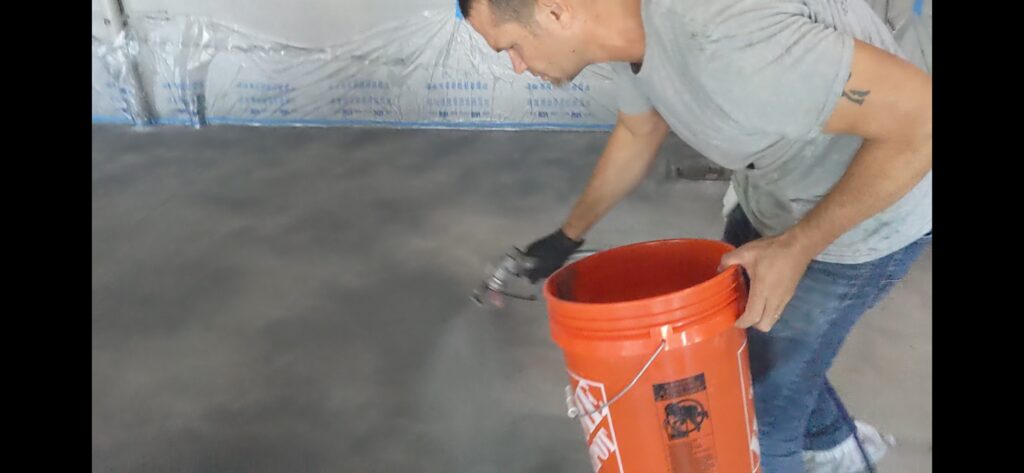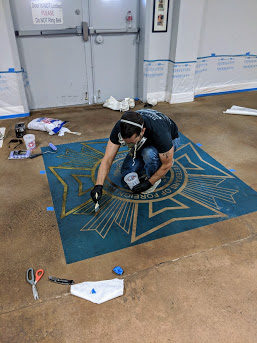Concrete Staining Products and Methods
Concrete staining products and methods have come a long way over the years. As a concrete staining contractor, you have to be able to adapt to the various situations that arise. For example, how porous is the concrete, how large is the project, where is the project located interior or exterior, will wind be a factor. This is just a few examples of that will factor into what concrete staining product and method you will use.

Let’s talk products. Concrete stains come in a variety of different solutions. I classify them in three categories:
- non-reactive concrete stains
- reactive concrete stains
- solid color concrete stains
Non-reactive concrete stains
Non-reactive concrete stains can be water based or solvent based such as used in concrete dyes. Water based tend to be easier to work with and more forgiving and usually can be sprayed from a pump sprayer. But this is not always the case it really depends on the manufacturer. Many water based stains are mineral based and are mixed with tap water to the desired dilution. There are some however that require reverse osmosis or distilled water to cut. Dyes are mixed with solvents such as acetone. They tend do dry very rapidly and cannot be sprayed out of a traditional pump sprayer. A drip from a dye if not addressed immediately will be permanent. It is important to read the manufacturers recommendations for installation.
Reactive concrete stains
A reactive stain is called such because it reacts with the concrete itself giving it various hues and tones. The color choices for reactive stains are limited to about eight. Most will yield colors tones with similar hues due to the chemical reactions they create. The advantage of a reactive stain is that it really is the only 100% UV stable stain on the market. The complexity in using them makes them a less popular item.
Solid color stains
In my personal opinion I do not consider this to be a stain at all. The characteristics are more like a paint than a stain. However the preparation to install needs to be the same as with reactive concrete stains and no-reactive concrete stains. The ease of install makes this a popular choice for DIYers and painters. It’s not the favorite among decorative concrete specialists in that there really is no creativity in this application unless you are doing a patter or something similar. Also when it’s installed by a concrete specialist it will actually be a solid color sealer. Meaning the stain or color, is the sealer.
Methods for installing concrete stain
Now the fun part, how do you install these products? Well first and formost prep is 90% of success or failure. Which is why, of course, we always recommend having them installed by professionals. Not to say it can’t be done by a DIYer. Even if you have the artistic ability chances are you won’t have the equipment needed.
For a basic application of a solid color sealer or solid color stain is a dip and roll method. This is of course after the proper method of prep has been completed. Generally it requires two coats and the first one would be rolled east to west while the second is north to south. Easy right? Where is the sun located when you’re doing this? Is is drying out the material too fast? Is the concrete outgassing causing bubbles? Yikes!
Water-based stains can typically be sprayed from a pump sprayer or bug sprayer. It’s important to apply randomly to not have a tell-tail visible pattern or lines. Don’t put too much down or puddle the product unless it’s a certain look you are going for. Watch the wind or airflow as it can move color where you don’t want it. Remember some require to be put down with an airless sprayer so the product can atomize correctly. That’s a whole other ballgame when working with that type of equipment.

Reactive concrete stain should not be attempted by a DYIer. There is a certain amount of danger to this product. Remember it is acid based. Acid can burn or even blind you! These products are sprayed from sprayers that are tolerant of acid. Yes, it could be sprayed form a traditional pump sprayer, but the seals may not hold up and start leaking which would ruin a project. Acid based stains must be neutralized once the reaction has finished. Depending on the manufacturer this could be from 4 to 24 hours. If all the residue is not cleaned up and it is sealed the sealer will peel off eventually.
If you would like more information about concrete staining, feel free to contact us.
